1. Introduction
Now that we understand how meiosis works, we can look at some meiosis-related issues:
- How, in mammals, chromosomes determine whether we’re male or female.
- How the process of meiosis can malfunction through a process called nondisjunction, which results in sperm or egg cells with extra or missing chromosomes.
- How these egg and sperm cells, if they go on to produce a zygote (a fertilized egg), can produce people with missing or extra chromosomes, resulting in conditions such as Down Syndrome, Turner Syndrome, and Klinefelter Syndrome.
2. Sex Determination in humans and other mammals
[qwiz style=”width: 600px !important;” repeat_incorrect=”false”] [h]
Identifying female and male chromosomal patterns
[q] Let’s start by examining the image below. One set consists of the chromosomes of a human male, and the second consists of those of a human female. Can you tell the difference? Make a guess, then click “Show the answer” to see the next slide.
[c]IFNob3cgdGhl IGFuc3dlcg==[Qq]
[f]IEp1c3QgYnkgbG9va2luZyBhdCB0aGVzZSBpbWFnZXMsIGl0JiM4MjE3O3MgcHJldHR5IG11Y2ggaW1wb3NzaWJsZS4gQnV0IGluIHRoZSBuZXh0IGltYWdlLCBJJiM4MjE3O2xsIHByZXNlbnQgdGhlc2UgY2hyb21vc29tZXMgYXMgYSBrYXJ5b3R5cGUsIGFuIGltYWdlIHRoYXQgc2hvd3MgdGhlIGNocm9tb3NvbWVzIGFycmFuZ2VkIGJ5IHNpemUuIENsaWNrICYjODIyMDtHb3QgaXQmIzgyMjE7IHdoZW4geW91JiM4MjE3O3JlIHJlYWR5IHRvIHByb2NlZWQu[Qq]
[q labels = “top”]Here are the karyotypes: Now give it a try.
[f*] Excellent. You must have noticed the “X” and “Y” chromosomes in the bottom right of this karyotype.
[fx] Sorry, that’s not correct. Take a look at the bottom right of this karyotype. Notice that the last pair of chromosomes is not matched, with the larger one labeled as “X” and the shorter one as “Y.” This is the pattern associated with people who are biologically male.
[f*] Good! You must have noticed the two “X” chromosomes in the bottom right of this karyotype.
[fx] No, that’s not correct. Take a look at the bottom right of this karyotype. Notice that the last pair of chromosomes are matched, with two equally sized chromosomes, both of which are labeled as “X.” This is the pattern associated with people who are biologically female.
[x]So, we’ve established that the chromosomal pattern of males and females is a bit different. Let’s dig deeper. Read below.
[/qwiz]
As we’ve seen earlier in this series of tutorials about meiosis, humans have 23 pairs of chromosomes, with one member of each pair contributed by the mother, and the other contributed by the father.
Here are two karyotypes. The one on the left is of a person who is chromosomally male. The one on the right is for a female.
| Male Karyotype | Female Karyotype |
 |
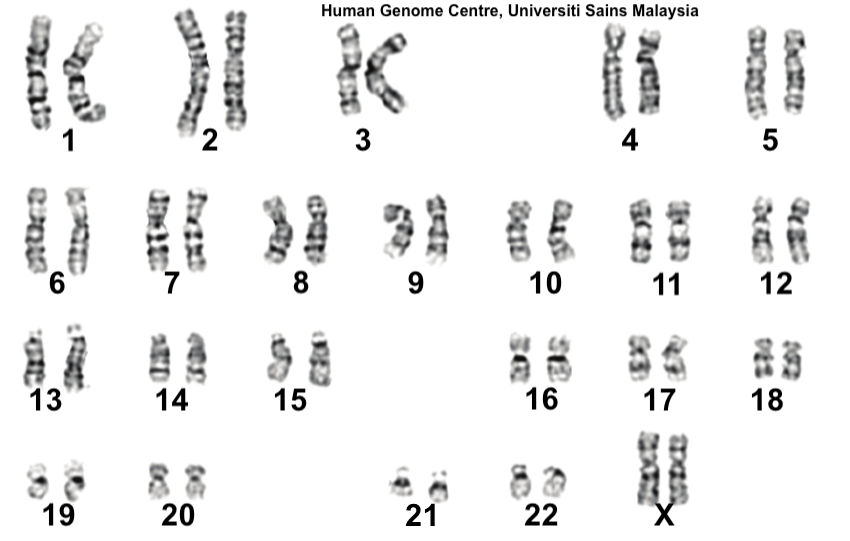 |
Chromosomes one through 22 are called autosomes. They have the same size, the same banding pattern, and the same genes (though the specific alleles and DNA base-pair sequences may differ).
The 23rd pair is the sex chromosomes, and that pair is what determines sex.
- Males have an X chromosome (the larger of the two) and a Y chromosome.
- Females have two X chromosomes.
So how does sex get determined? Answer the question below:
[qwiz style=”min-height: 200px !important;”]
[q multiple_choice=”true”] Sex is determined by
[c]IFRoZSB0eXBlIG9mIGVnZyB5b3VyIG1vdGhlciBwYXNzZWQgb24gdG8geW91Lg==[Qq]
[f]IE5vLiBTZXggaXMgZGV0ZXJtaW5lZCBieSB0aGUgc3Blcm0gY2VsbCB0aGF0IGZlcnRpbGl6ZWQgeW91ciBtb3RoZXImIzgyMTc7cyBlZ2cuIFJlYWQgbW9yZSBiZWxvdy4=[Qq]
[c]IFRoZSB0eXBlIG9mIHNwZXJtIHRoYXQgZmVydGls aXplZCB5b3VyIG1vdGhlciYjODIxNztzIGVnZy4=[Qq]
[f]IFllcyEgVGhlIHNwZXJtIHRoYXQgZmVydGlsaXplZCB5b3VyIG1vdGhlciYjODIxNztzIGVnZyBkZXRlcm1pbmVkIHdoZXRoZXIgeW91JiM4MjE3O3JlIG1hbGUgb3IgZmVtYWxlLiBSZWFkIG1vcmUgYmVsb3cu[Qq]
[/qwiz]
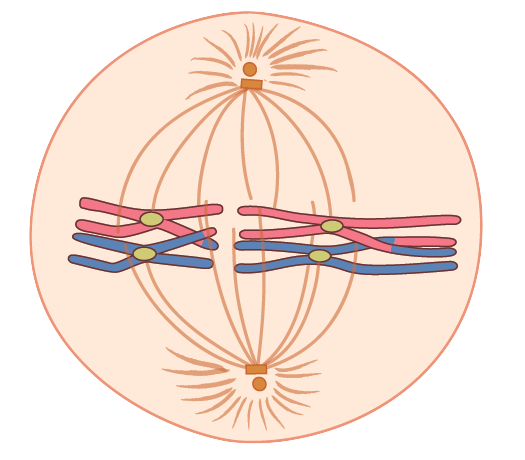
Here’s how it works. As you know, during meiosis homologous pairs pair up and then get split apart. The image below shows the pairing up of homologs that would happen in a cell with four chromosomes (two homologous pairs).
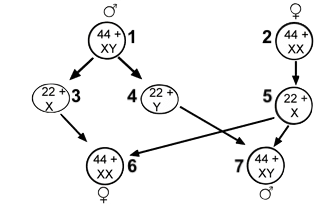
As far as meiosis goes, the sex chromosomes are also homologs, and like every other homologous pair, they pair up during prophase 1, line up along the cell equator during metaphase 1, and split apart during anaphase 1. Cells “1” and “2,” at right, show the chromosomal situation in the gamete-producing germ cells in the parents that are about to undergo meiosis, with “1” representing the father and “2” representing the mother. Note that the notation “44 + XY” means that there are 44 autosomes, plus an X chromosome and a Y chromosome (for a total of 46).
Cells “3,” “4,” and “5” show the gametes that the male and female germ cells can produce.
In a germ cell within a man’s testes, the X and Y chromosomes will pair up, and then separate. The result will be that half of the haploid sperm cells will carry an X chromosome (as shown in “3”), and half will carry a Y chromosome (as shown in “4”).
In a female germ cell, where two X chromosomes are paired up, the only possible result is a haploid egg with an X chromosome, as is shown in “5.”
Cells “6” and “7” show the two types of zygotes that can result. If an X-chromosome carrying sperm (cell “3”) fertilizes the X-chromosome-carrying egg, then a diploid zygote with two X chromosomes (XX) results. That zygote will develop into a female. If a Y-chromosome carrying sperm (cell “4”) fertilizes the egg, then the result will be a zygote with an X and a Y chromosome (XY), which will develop into a male.
3. Sex Determination in Mammals Quiz
The X-Y chromosome system for sex determination is found in humans and all other mammals. But note that one’s chromosomal arrangement isn’t always correlated with the sex that one is assigned at birth, and the sex that one is assigned at birth can differ from one’s gender identity and sexuality.
Use the quiz below to test your mastery of human chromosomal sex determination.
[qwiz random = “true” qrecord_id=”sciencemusicvideosMeister1961-Sex Determination in Mammals (v2.0)”]
[h]Sex Determination in Mammals
[i]
[q] In the diagram below, the father’s germ cell is represented by
[textentry single_char=”true”]
[c]ID E=[Qq]
[f]IENvcnJlY3QhIFRoZSBmYXRoZXImIzgyMTc7cyBnZXJtIGNlbGwgaXMgcmVwcmVzZW50ZWQgYnkgJiM4MjIwOzEuJiM4MjIxOw==[Qq]
[c]IEVudGVyIHdvcmQ=[Qq]
[f]IE5vLg==[Qq]
[c]ICo=[Qq]
[f]IE5vLiBIZXJlJiM4MjE3O3MgYSBoaW50LiBUaGUgZmF0aGVyJiM4MjE3O3MgZ2VybSBjZWxsIHdpbGwgaGF2ZSBhIHRvdGFsIG9mIDQ2IGNocm9tb3NvbWVzLCB0d28gb2Ygd2hpY2ggd2lsbCBiZSAmIzgyMjA7WCYjODIyMTsgYW5kICYjODIyMDtZLiYjODIyMTs=[Qq]
[q] In the diagram below, the mother’s germ cell is represented by
[textentry single_char=”true”]
[c]ID I=[Qq]
[f]IENvcnJlY3QhIFRoZSBtb3RoZXImIzgyMTc7cyBnZXJtIGNlbGwgaXMgcmVwcmVzZW50ZWQgYnkgJiM4MjIwOzIuJiM4MjIxOw==[Qq]
[c]IEVudGVyIHdvcmQ=[Qq]
[f]IE5vLg==[Qq]
[c]ICo=[Qq]
[f]IE5vLiBIZXJlJiM4MjE3O3MgYSBoaW50LiBUaGUgbW90aGVyJiM4MjE3O3MgZ2VybSBjZWxsIHdpbGwgaGF2ZSBhIHRvdGFsIG9mIDQ2IGNocm9tb3NvbWVzLCBhbmQgdHdvIG9mIHRoZXNlIHdpbGwgYmUgWCBjaHJvbW9zb21lcy4=[Qq]
[q] In the diagram below, the sperm cell that will produce a female is represented by
[textentry single_char=”true”]
[c]ID M=
[f]IENvcnJlY3QhIEEgc3Blcm0gY2VsbCB0aGF0IHdpbGwgY3JlYXRlIGEgZmVtYWxlIHp5Z290ZSBpcyByZXByZXNlbnRlZCBieSAmIzgyMjA7My4mIzgyMjE7[Qq]
[c]IEVudGVyIHdvcmQ=[Qq]
[f]IE5vLg==[Qq]
[c]ICo=[Qq]
[f]IE5vLiBIZXJlJiM4MjE3O3MgYSBoaW50LiBGaW5kIGEgY2VsbCB0aGF0IGhhcyAyMiBjaHJvbW9zb21lcywgcGx1cyBhICYjODIyMDtZJiM4MjIxOyBjaHJvbW9zb21lLg==[Qq]
[q] In the diagram below, the sperm cell that will produce a male is represented by
[textentry single_char=”true”]
[c]ID Q=[Qq]
[f]IENvcnJlY3QhIEEgc3Blcm0gY2VsbCB0aGF0IHdpbGwgY3JlYXRlIGEgbWFsZSB6eWdvdGUgaXMgcmVwcmVzZW50ZWQgYnkgJiM4MjIwOzQuJiM4MjIxOw==[Qq]
[c]IEVudGVyIHdvcmQ=[Qq]
[f]IE5vLg==[Qq]
[c]ICo=[Qq]
[f]IE5vLiBIZXJlJiM4MjE3O3MgYSBoaW50LiBGaW5kIGEgY2VsbCB0aGF0IGhhcyAyMiBjaHJvbW9zb21lcywgcGx1cyBhbiAmIzgyMjA7WCYjODIyMTsgY2hyb21vc29tZS4=[Qq]
[q] In the diagram below, an unfertilized egg cell is represented by
[textentry single_char=”true”]
[c]ID U=
[f]IENvcnJlY3QhIEFuIHVuZmVydGlsaXplZCBlZ2cgY2VsbCBpcyByZXByZXNlbnRlZCBieSAmIzgyMjA7NS4mIzgyMjE7[Qq]
[c]IEVudGVyIHdvcmQ=[Qq]
[f]IE5vLg==[Qq]
[c]ICo=[Qq]
[f]IE5vLiBIZXJlJiM4MjE3O3MgYSBoaW50LiBGaW5kIGEgY2VsbCB0aGF0IGhhcyAyMiBjaHJvbW9zb21lcywgcGx1cyBhbiAmIzgyMjA7WCYjODIyMTsgY2hyb21vc29tZS4=[Qq]
[q] In the diagram below, a female zygote is represented by
[textentry single_char=”true”]
[c]ID Y=[Qq]
[f]IENvcnJlY3QhIEEgZmVtYWxlIHp5Z290ZSBpcyByZXByZXNlbnRlZCBieSAmIzgyMjA7Ni4mIzgyMjE7[Qq]
[c]IEVudGVyIHdvcmQ=[Qq]
[f]IE5vLg==[Qq]
[c]ICo=[Qq]
[f]IE5vLiBIZXJlJiM4MjE3O3MgYSBoaW50LiBGaW5kIGEgenlnb3RlIChib3R0b20gcm93IG9ubHkpIHRoYXQgaGFzIDQ0IGNocm9tb3NvbWVzLCBwbHVzIHR3byAmIzgyMjA7WCYjODIyMTsgY2hyb21vc29tZXMu[Qq]
[q] In the diagram below, a male zygote is represented by
[textentry single_char=”true”]
[c]ID c=[Qq]
[f]IENvcnJlY3QhIEEgbWFsZSB6eWdvdGUgaXMgcmVwcmVzZW50ZWQgYnkgJiM4MjIwOzcuJiM4MjIxOw==[Qq]
[c]IEVudGVyIHdvcmQ=[Qq]
[f]IE5vLg==[Qq]
[c]ICo=[Qq]
[f]IE5vLiBIZXJlJiM4MjE3O3MgYSBoaW50LiBGaW5kIGEgenlnb3RlIChib3R0b20gcm93IG9ubHkpIHRoYXQgaGFzIDQ0IGNocm9tb3NvbWVzLCBwbHVzIGFuICYjODIyMDtYJiM4MjIxOyBjaHJvbW9zb21lIGFuZCBhICYjODIyMDtZJiM4MjIxOyBjaHJvbW9zb21lLg==[Qq]
[q] In the diagram below, sperm “1” must be carrying a(n) ____ chromosome.
[textentry single_char=”true”]
[c]IF k=[Qq]
[f]IENvcnJlY3QuIFNwZXJtIGNlbGwgIyAxIG11c3QgYmUgY2FycnlpbmcgYSBZIGNocm9tb3NvbWUgKGJlY2F1c2UgdGhlIGVnZyBpdCBmZXJ0aWxpemVkIGdhdmUgcmlzZSB0byBhIGJveSku[Qq]
[c]IEVudGVyIHdvcmQ=[Qq]
[c]ICo=[Qq]
[f]IE5vLiBTcGVybSAjIDEgZmVydGlsaXplZCB0aGUgZWdnIGF0ICYjODIyMDszLCYjODIyMTsgcmVzdWx0aW5nIGluIHRoZSBib3kgYXQgJiM4MjIwOzUuJiM4MjIxOyBGb3IgdGhhdCB0byBoYXBwZW4sIHdvdWxkIHRoZSBzcGVybSBoYXZlIGNhcnJpZWQgYW4gJiM4MjIwO1gmIzgyMjE7IG9yIGEgJiM4MjIwO1kmIzgyMjE7IGNocm9tb3NvbWU/[Qq]
[q] In the diagram below, sperm “2” must be carrying a(n) ____ chromosome.
[textentry single_char=”true”]
[c]IF g=[Qq]
[f]IENvcnJlY3QuIFNwZXJtIGNlbGwgIyAyIG11c3QgYmUgY2FycnlpbmcgYW4gWCBjaHJvbW9zb21lIChiZWNhdXNlIHRoZSBlZ2cgaXQgZmVydGlsaXplZCBnYXZlIHJpc2UgdG8gYSBnaXJsKS4=[Qq]
[c]IEVudGVyIHdvcmQ=[Qq]
[c]ICo=[Qq]
[f]IE5vLiBTcGVybSAjIDEgZmVydGlsaXplZCB0aGUgZWdnIGF0ICYjODIyMDszLCYjODIyMTsgcmVzdWx0aW5nIGluIHRoZSBib3kgYXQgJiM4MjIwOzUuJiM4MjIxOyBGb3IgdGhhdCB0byBoYXBwZW4sIHdvdWxkIHRoZSBzcGVybSBoYXZlIGNhcnJpZWQgYW4gJiM4MjIwO1gmIzgyMjE7IG9yIGEgJiM4MjIwO1kmIzgyMjE7IGNocm9tb3NvbWU/[Qq]
[q] In the diagram below, the eggs at “3” or “4” must be carrying a(n) ____ chromosome.
[textentry single_char=”true”]
[c]IF g=[Qq]
[f]IENvcnJlY3QuIFVuZmVydGlsaXplZCBlZ2dzIGNhbiBvbmx5IGNhcnJ5IGFuIFggY2hyb21vc29tZS4=[Qq]
[c]IEVudGVyIHdvcmQ=[Qq]
[c]ICo=[Qq]
[f]IE5vLiBVbmZlcnRpbGl6ZWQgZWdncyBmcm9tIGZlbWFsZSBnZXJtIGNlbGxzIHdpdGggdHdvIFggY2hyb21vc29tZXMgKCYjODIyMDtYWCYjODIyMTspLiBXaGVuIHRob3NlIFggY2hyb21vc29tZXMgc2VwYXJhdGUgZHVyaW5nIGFuYXBoYXNlIDEsIGVhY2ggcmVzdWx0aW5nIGhhcGxvaWQgZWdnIHdpbGwgaGF2ZSBhbiBYIGNocm9tb3NvbWUgKG5ldmVyIGEgWSkuIFJlbWVtYmVyIHRoYXQgdGhlIG5leHQgdGltZSB5b3Ugc2VlIHRoaXMgcXVlc3Rpb24u[Qq]
[q] In the diagram below, which number refers to a cell or organism that would have an X and a Y chromosome?
[textentry single_char=”true”]
[c]ID U=[Qq]
[f]IENvcnJlY3QuIFRoZSBib3kgYXQgJiM4MjIwOzUmIzgyMjE7IGlzIGEgYm95IGJlY2F1c2UgaGUgaGFzIGFuIFggYW5kIGEgWSBjaHJvbW9zb21lIGluIGVhY2ggb2YgaGlzIGNlbGxzLg==[Qq]
[c]IEVudGVyIHdvcmQ=[Qq]
[c]ICo=[Qq]
[f]IE5vLiBIZXJlJiM4MjE3O3MgYSBoaW50LiBUaGUgc3Blcm0gYXQgJiM4MjIwOzEmIzgyMjE7IGhhZCB0byBjYXJyeSBhICYjODIyMDtZJiM4MjIxOyBjaHJvbW9zb21lLiBhbmQgdGhlIGVnZyBhdCAmIzgyMjA7MyYjODIyMTsgaGFkIHRvIGNhcnJ5IGFuICYjODIyMDtYJiM4MjIxOyBjaHJvbW9zb21lLiBXaG8gaGFzIHRvIGhhdmUgYm90aA==IGFuIFggYW5kIGEgWT8=[Qq]
[x][restart]
[/qwiz]
4. Other Sex Determination Systems
Among living things, male and female are not universal attributes. Many worms, for example, are hermaphrodites, with both sperm-producing testes and egg-producing ovaries. Most plants are hermaphroditic as well. Fungi have thousands of mating types.
Among our non-mammalian animal cousins which are male or female, there are three additional systems that you, as an AP Biology student, should know about.
4a. Temperature-Dependent Sex Determination
Most reptiles lay eggs. For example, a female sea turtle will mate at sea, and then crawl up on a sandy beach to dig out a hole in the sand and lay her eggs within it. Within that hole, the eggs on the bottom (further from the sun) will develop at a cooler temperature, while those on top will develop at a warmer temperature.
 |
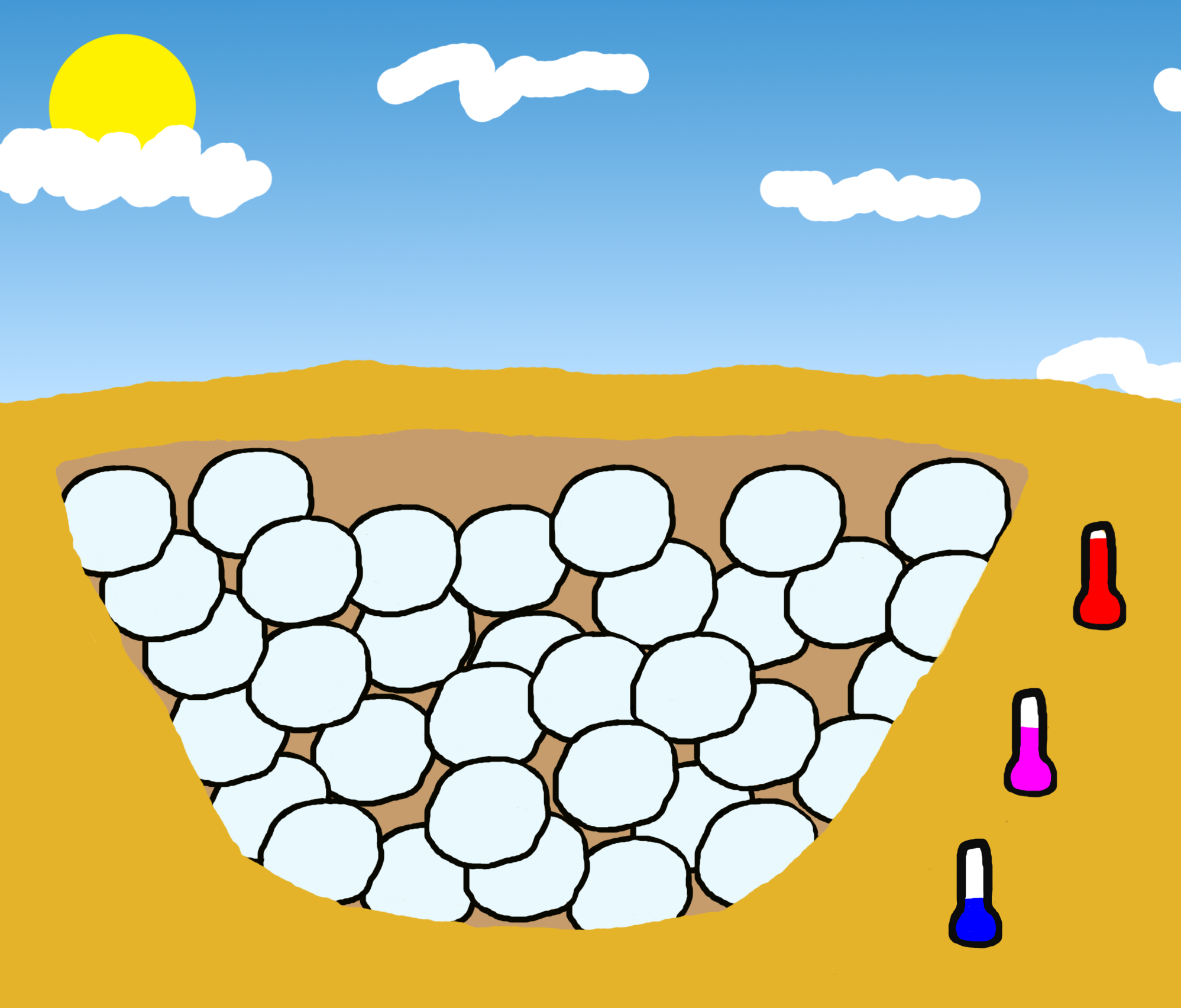 |
| A sea turtle laying eggs | Cross section of a sea turtle nest |
In three groups of reptiles, this difference in temperature determines the sex of the offspring. The image below shows three variations of how this works among three groups of reptiles.
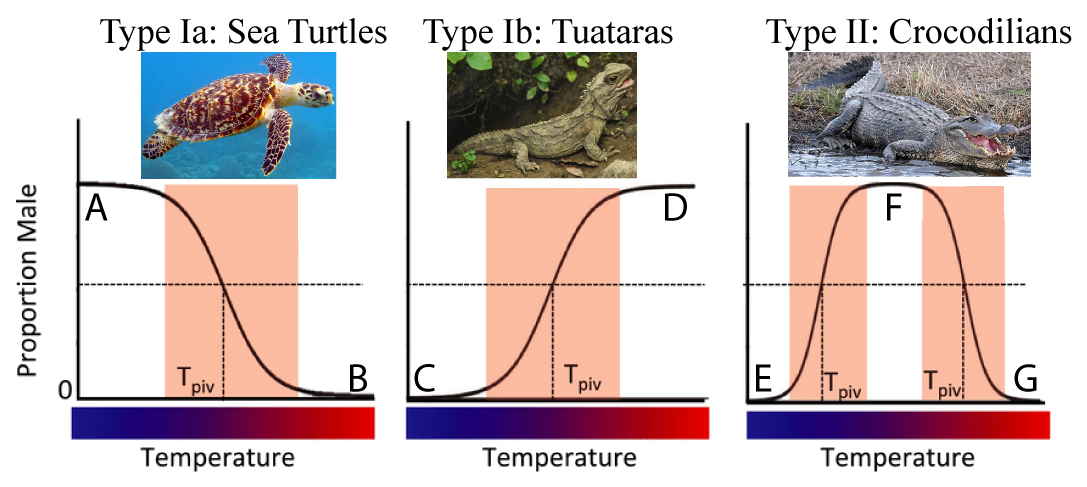
In sea turtles, the eggs that develop in cooler temperatures (point “A in the image on the left) will develop into males. At higher temperatures, eggs will develop into females. Tpiv is the pivot point. Below the pivot point, eggs develop into males; above it, the eggs develop into females.
Tuataras are reptiles that live in New Zealand. Though they look like reptiles, they’re part of a distinct lineage that split apart from lizards and snakes about 250 million years ago.
In Tuataras, temperature-dependent sex determination follows an opposite pattern from that in sea turtles. Below the pivot point, eggs develop into females; above it, the eggs develop into males.
Crocodilians, which include both alligators and crocodiles, have a third pattern in which there are two pivot points. In the coolest and warmest temperatures, eggs develop into females. At intermediate temperatures, eggs develop into males.
How, on a cellular and organismal level, might temperature-dependent sex determination work? Read this lightly edited passage from the Embryo Project Encyclopedia:
One cause of temperature-dependent sex determination is the enzyme aromatase. Aromatase helps to convert the male sex hormone testosterone into the female sex hormone estrogen. Individuals with low levels of aromatase during a temperature-sensitive period will develop male characteristics. High levels of aromatase activity increase the production of female hormones, resulting in the development of female characteristics.
During the temperature-sensitive period, variations in temperature change the activity of aromatase. This change in activity enables individuals to develop into males or females depending on the temperatures experienced. Although other environmental influences can have similar effects, the temperature is the most widespread factor that alters aromatase activity and sex determination.
4b. ZZ/ZW System in Birds
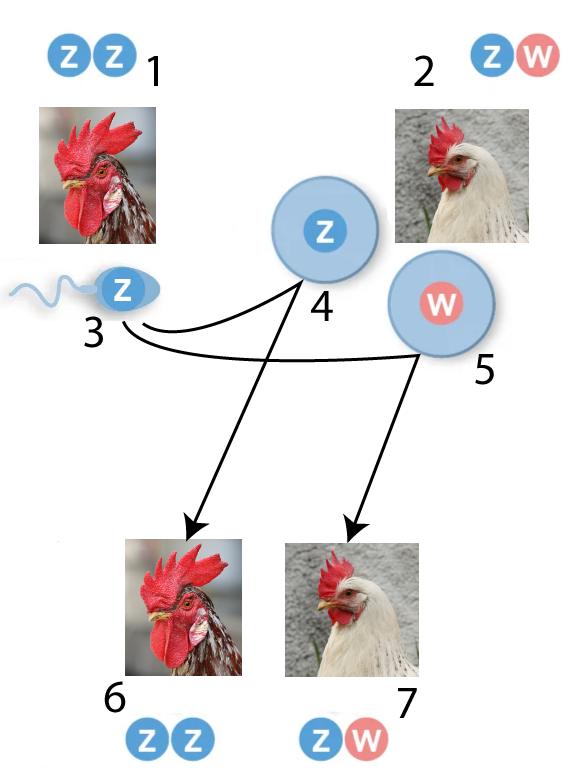
Birds, like mammals, have a sex determination system that’s based on chromosomes. In this system, the sex chromosomes are designated as “Z” and “W.” A zygote with two “Z” chromosomes (ZZ) will develop into a male. A zygote with a “Z” and a “W” chromosome will develop into a female.
In the ZZ/ZW system, it’s the female’s gametes that determine the sex of the offspring. When a female produces eggs, there’s a 50% chance of that egg receiving a “Z” chromosome and a 50% chance of it receiving a “W.” Eggs with Z chromosomes, when fertilized by a Z-carrying sperm, will develop into ZZ males. Eggs with W chromosomes, when fertilized by a Z-carrying sperm, will develop into ZW females.
4c. Haplodiploidy in Bees
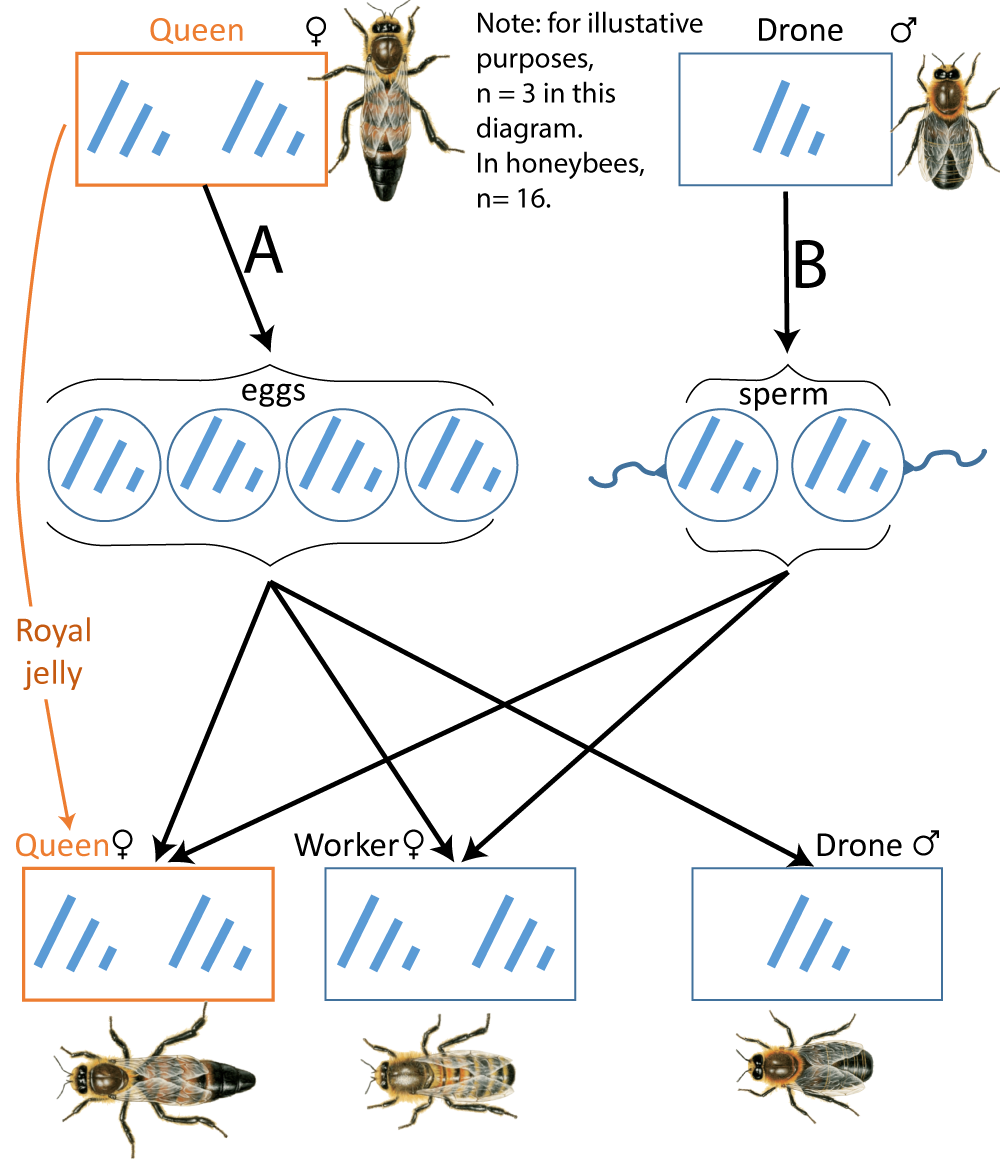 In bees, ants, wasps and a few other groups of species, sex is determined by a system called haplodiploidy. In what follows, we’ll focus on haplodiploidy in honeybees. Among other haplodiploid species, there are many variations in how the system works.
In bees, ants, wasps and a few other groups of species, sex is determined by a system called haplodiploidy. In what follows, we’ll focus on haplodiploidy in honeybees. Among other haplodiploid species, there are many variations in how the system works.
In all haplodiploid sex-determination systems, males are haploid: they develop from unfertilized eggs. Females are diploid and develop when a female’s haploid eggs are fertilized by a male’s haploid sperm, creating a diploid zygote.
In honeybees, haploid eggs develop into male drones. Drones are males whose sole purpose is to mate with the queen. They don’t collect pollen, create honey, or defend the hive (they lack stingers and venom). Once the queen is successfully fertilized, the workers kick the drones out of the hive, after which the drones die.
Fertilized eggs have two fates. Most fertilized eggs develop into non-reproductive female workers who perform all the work of the colony. One fertilized egg (out of the tens of thousands available) will develop into a queen, the only egg-laying female in a hive. The difference between queen and worker isn’t genetic: it’s developmental. The workers choose one fertilized egg to become the queen and feed that egg royal jelly, a protein-rich secretion that induces changes that lead that egg to develop into a queen.
Haplodiploidy is thought to explain much of the social behavior that’s found in bees and ants. You’ll learn more about the connection between haplodiploidy and animal behavior in AP Bio Unit 8.
5. Sex determination in Humans and Other Animals: Checking Understanding
[qwiz qrecord_id=”sciencemusicvideosMeister1961-Sex Determination in Humans and Other Animals (v2.0)”]
[h] Sex Determination
[q multiple_choice=”true”] In these animals, sex is determined by the inheritance of a specific sex-inducing chromosome that comes from the male gamete.
[c]IGJpcmRz[Qq]
[f]IE5vLiBCaXJkcyBoYXZlIGEgWlovWlcgc3lzdGVtLiBJdCYjODIxNztzIHRoZSBmZW1hbGUgZ2FtZXRlIHRoYXQgZGV0ZXJtaW5lcyB0aGUgc2V4IG9mIHRoZSBvZmZzcHJpbmcu[Qq]
[c]IG1hbW 1hbHM=[Qq]
[f]IE5pY2UhIE1hbW1hbHMgaGF2ZSBhbiBYWC9YWSBzZXgtZGV0ZXJtaW5hdGlvbiBzeXN0ZW0gaW4gd2hpY2ggdGhlIHNwZXJtLCBieSBkZWxpdmVyaW5nIGFuIFggb3IgYSBZIGNocm9tb3NvbWUsIGRldGVybWluZXMgdGhlIHNleCBvZiB0aGUgb2Zmc3ByaW5nLg==[Qq]
[c]IHNlYSB0dXJ0bGVzLCB0dWF0YXJhcywgYW5kIGNyb2NvZGlsaWFucw==[Qq]
[f]IE5vLiBJbiB0aGVzZSByZXB0aWxlcywgc2V4IGRldGVybWluYXRpb24gaXMgdGVtcGVyYXR1cmUtZGVwZW5kZW50Lg==[Qq]
[c]IGhvbmV5YmVl[Qq]
[f]IE5vLiBIb25leWJlZXMgaGF2ZSBhIGhhcGxvZGlwbG9pZCBzeXN0ZW0uIE1hbGVzIGRldmVsb3AgZnJvbSB1bmZlcnRpbGl6ZWQgZWdncywgYW5kIGZlbWFsZXMgZGV2ZWxvcCBmcm9tIGZlcnRpbGl6ZWQgZWdncy4=[Qq]
[q multiple_choice=”true”] In these animals, sex is determined by the inheritance of a specific sex-inducing chromosome that comes from the female gamete.
[c]IGJp cmRz[Qq]
[f]IFllcy4gQmlyZHMgaGF2ZSBhIFpaL1pXIHN5c3RlbSBpbiB3aGljaCBmZW1hbGVzIGhhdmUgYSBaVyBjaHJvbW9zb21lIHBhdHRlcm4uIElmIHRoZSBlZ2cgaGFzIGEgWiBjaHJvbW9zb21lLCB0aGUgb2Zmc3ByaW5nIHdpbGwgYmUgYSBaWiBtYWxlLiBJZiB0aGUgZWdnIGhhcyBhIFcgY2hyb21vc29tZSB0aGUgb2Zmc3ByaW5nIHdpbGwgYmUgWlcgZmVtYWxlLg==[Qq]
[c]IG1hbW1hbHM=[Qq]
[f]IE5vLiBNYW1tYWxzIGhhdmUgYW4gWFgvWFkgc2V4LWRldGVybWluYXRpb24gc3lzdGVtIGluIHdoaWNoIHRoZSBzcGVybSwgYnkgZGVsaXZlcmluZyBhbiBYIG9yIGEgWSBjaHJvbW9zb21lLCBkZXRlcm1pbmVzIHRoZSBzZXggb2YgdGhlIG9mZnNwcmluZy4=[Qq]
[c]IHNlYSB0dXJ0bGVzLCB0dWF0YXJhcywgYW5kIGNyb2NvZGlsaWFucw==[Qq]
[f]IE5vLiBJbiB0aGVzZSByZXB0aWxlcywgc2V4IGRldGVybWluYXRpb24gaXMgdGVtcGVyYXR1cmUtZGVwZW5kZW50Lg==[Qq]
[c]IGhvbmV5YmVlcw==[Qq]
[f]IE5vLiBIb25leWJlZXMgaGF2ZSBhIGhhcGxvZGlwbG9pZCBzeXN0ZW0uIE1hbGVzIGRldmVsb3AgZnJvbSB1bmZlcnRpbGl6ZWQgZWdncywgYW5kIGZlbWFsZXMgZGV2ZWxvcCBmcm9tIGZlcnRpbGl6ZWQgZWdncy4=[Qq]
[q multiple_choice=”true”] In these animals, sex is determined by the temperature at which the eggs develop.
[c]IGJpcmRz[Qq]
[f]IE5vLiBCaXJkcyBoYXZlIGEgWlovWlcgc3lzdGVtIGluIHdoaWNoIGZlbWFsZXMgaGF2ZSBhIFpXIGNocm9tb3NvbWUgcGF0dGVybi4gSWYgdGhlIGVnZyBoYXMgYSBaIGNocm9tb3NvbWUsIHRoZSBvZmZzcHJpbmcgd2lsbCBiZSBhIFpaIG1hbGUuIElmIHRoZSBlZ2cgaGFzIGEgVyBjaHJvbW9zb21lIHRoZSBvZmZzcHJpbmcgd2lsbCBiZSBaVyBmZW1hbGUu[Qq]
[c]IG1hbW1hbHM=[Qq]
[f]IE5vLiBNYW1tYWxzIGhhdmUgYW4gWFgvWFkgc2V4LWRldGVybWluYXRpb24gc3lzdGVtIGluIHdoaWNoIFhZIG1hbGVzIHByb2R1Y2Ugc3Blcm0gdGhhdCBoYXMgZWl0aGVyIGFuIFggb3IgYSBZIGNocm9tb3NvbWUuIFgtYmVhcmluZyBzcGVybSByZXN1bHQgaW4gZmVtYWxlIChYWCkgb2Zmc3ByaW5nLiBZLWJlYXJpbmcgc3Blcm0gcmVzdWx0IGluIG1hbGUgKFhZKSBvZmZzcHJpbmcu[Qq]
[c]IHNlYSB0dXJ0bGVzLCB0dWF0YXJh cywgYW5kIGNyb2NvZGlsaWFucw==[Qq]
[f]IE5pY2UgSm9iISBJbiB0aGVzZSByZXB0aWxlcywgc2V4IGRldGVybWluYXRpb24gaXMgdGVtcGVyYXR1cmUtZGVwZW5kZW50Lg==[Qq]
[c]IGhvbmV5YmVlcw==[Qq]
[f]IE5vLiBIb25leWJlZXMgaGF2ZSBhIGhhcGxvZGlwbG9pZCBzeXN0ZW0uIE1hbGVzIGRldmVsb3AgZnJvbSB1bmZlcnRpbGl6ZWQgZWdncywgYW5kIGZlbWFsZXMgZGV2ZWxvcCBmcm9tIGZlcnRpbGl6ZWQgZWdncy4=[Qq]
[q multiple_choice=”true”] In these animals, males develop from unfertilized eggs; females develop from fertilized eggs.
[c]IGJpcmRz[Qq]
[f]IE5vLiBCaXJkcyBoYXZlIGEgWlovWlcgc3lzdGVtIGluIHdoaWNoIGZlbWFsZXMgaGF2ZSBhIFpXIGNocm9tb3NvbWUgcGF0dGVybi4gSWYgdGhlIGVnZyBoYXMgYSBaIGNocm9tb3NvbWUsIHRoZSBvZmZzcHJpbmcgd2lsbCBiZSBhIFpaIG1hbGUuIElmIHRoZSBlZ2cgaGFzIGEgVyBjaHJvbW9zb21lIHRoZSBvZmZzcHJpbmcgd2lsbCBiZSBaVyBmZW1hbGUu[Qq]
[c]IG1hbW1hbHM=[Qq]
[f]IE5vLiBNYW1tYWxzIGhhdmUgYW4gWFgvWFkgc2V4LWRldGVybWluYXRpb24gc3lzdGVtIGluIHdoaWNoIFhZIG1hbGVzIHByb2R1Y2Ugc3Blcm0gdGhhdCBoYXZlIGVpdGhlciBhbiBYIG9yIGEgWSBjaHJvbW9zb21lLiBYLWJlYXJpbmcgc3Blcm0gcmVzdWx0IGluIGZlbWFsZSAoWFgpIG9mZnNwcmluZy4gWS1iZWFyaW5nIHNwZXJtIHJlc3VsdCBpbiBtYWxlIChYWSkgb2Zmc3ByaW5nLg==[Qq]
[c]IHNlYSB0dXJ0bGVzLCB0dWF0YXJhcywgYW5kIGNyb2NvZGlsaWFucw==[Qq]
[f]IE5vISBJbiB0aGVzZSByZXB0aWxlcywgc2V4IGRldGVybWluYXRpb24gaXMgdGVtcGVyYXR1cmUtZGVwZW5kZW50Lg==[Qq]
[c]IGhvbmV5 YmVlcw==[Qq]
[f]IFllcy4gSG9uZXliZWVzIChhbG9uZyB3aXRoIG90aGVyIGJlZXMsIHdhc3BzLCBhbmQgYW50cykgaGF2ZSBhIGhhcGxvZGlwbG9pZCBzeXN0ZW0uIE1hbGVzIGRldmVsb3AgZnJvbSB1bmZlcnRpbGl6ZWQgZWdncywgYW5kIGZlbWFsZXMgZGV2ZWxvcCBmcm9tIGZlcnRpbGl6ZWQgZWdncy4=[Qq]
[q multiple_choice=”true”] The diagram below shows a female and a male fruit fly. Below the flies, you can see the sex chromosomes associated with each sex. Based on the diagram, you can predict that
[c]IHNleCBkZXRlcm1pbmF0aW9uIGluIGZydWl0IGZsaWVzIHdvcmtzIGFzIGl0IGRvZXMgaW4gaG9uZXliZWVzLCB3aXRoIHRoZSBmZW1hbGUgcHJvZHVjaW5nIGEgZ2FtZXRlIHRoYXQgZGV0ZXJtaW5lcyB0aGUgc2V4IG9mIHRoZSBvZmZzcHJpbmcu[Qq]
[f]IE5vLiBJbiBob25leWJlZXMsIG1hbGVzIGFyZSBoYXBsb2lkLCBhbmQgZmVtYWxlcyBhcmUgZGlwbG9pZC4gVGhlIGZhY3QgdGhhdCBhIG1hbGUgZnJ1aXQgZmx5IGhhcyBib3RoIGFuIFggYW5kIGEgWSBjaHJvbW9zb21lIGluZGljYXRlcyB0aGF0IG1hbGUgZnJ1aXQgZmxpZXMgYXJlIGRpcGxvaWQuIEhlcmUmIzgyMTc7cyBhIGhpbnQgZm9yIG5leHQgdGltZTogd2hhdCBhbmltYWxzIGRvIHlvdSBrbm93IGFib3V0IGluIHdoaWNoIHRoZSBmZW1hbGVzIGFyZSBYWCBhbmQgdGhlIG1hbGVzIGFyZSBYWT8=[Qq]
[c]IFNleCBkZXRlcm1pbmF0aW9uIGluIGZydWl0IGZsaWVzIHdvcmtzIGFzIGl0IGRvZXMgaW4gYmlyZHMsIHdpdGggdGhlIGZlbWFsZSBwcm9kdWNpbmcgYSBnYW1ldGUgdGhhdCBkZXRlcm1pbmVzIHRoZSBzZXggb2YgdGhlIG9mZnNwcmluZy4=[Qq]
[f]IE5vLiBJbiBiaXJkcywgdGhlIGZlbWFsZSBoYXMgdHdvIGRpZmZlcmVudCBzZXggY2hyb21vc29tZXMsIFogYW5kIFcuIEluIGZydWl0IGZsaWVzLCB0aGUgZmVtYWxlIGhhcyB0d28gWCBjaHJvbW9zb21lcy4gVGhlcmVmb3JlLMKgIHRoZSBmZW1hbGUgY2FuIG9ubHkgcGFzcyBvbiBhbiBYIGNocm9tb3NvbWUuIEhlcmUmIzgyMTc7cyBhIGhpbnQgZm9yIG5leHQgdGltZTogd2hhdCBhbmltYWxzIGRvIHlvdSBrbm93IGFib3V0IGluIHdoaWNoIHRoZSBmZW1hbGVzIGFyZSBYWCBhbmQgdGhlIG1hbGVzIGFyZSBYWT8=[Qq]
[c]IHNleCBkZXRlcm1pbmF0aW9uIGlzIHRlbXBlcmF0dXJlIGRlcGVuZGVudC4=[Qq]
[f]IE5vLiBJbiB0ZW1wZXJhdHVyZS1kZXBlbmRlbnQgc2V4IHNlbGVjdGlvbiwgdGhlcmUmIzgyMTc7cyBubyBjaHJvbW9zb21hbCBkaWZmZXJlbmNlIGJldHdlZW4gbWFsZXMgYW5kIGZlbWFsZXMuIEhlcmUmIzgyMTc7cyBhIGhpbnQgZm9yIG5leHQgdGltZTogd2hhdCBhbmltYWxzIGRvIHlvdSBrbm93IGFib3V0IGluIHdoaWNoIHRoZSBmZW1hbGVzIGFyZSBYWCBhbmQgdGhlIG1hbGVzIGFyZSBYWT8=[Qq]
[c]IFNleCBkZXRlcm1pbmF0aW9uIGluIGZydWl0IGZsaWVzIHdvcmtzIGFzIGl0IGRvZXMgaW4gbWFtbWFscywgd2l0aCB0 aGUgbWFsZSBwcm9kdWNpbmcgYSBnYW1ldGUgdGhhdCBkZXRlcm1pbmVzIHRoZSBzZXggb2YgdGhlIG9mZnNwcmluZy4=[Qq]
[f]IENvcnJlY3QhIE1hbGUgZnJ1aXQgZmxpZXMgaGF2ZSBhbiBYIGFuZCBhIFkgY2hyb21vc29tZS4gQXMgaW4gbWFtbWFscywgWFkgbWFsZXMgcHJvZHVjZSBzcGVybSB0aGF0IGhhdmUgZWl0aGVyIGFuIFggb3IgYSBZIGNocm9tb3NvbWUuIFgtYmVhcmluZyBzcGVybSByZXN1bHQgaW4gZmVtYWxlIChYWCkgb2Zmc3ByaW5nLiBZLWJlYXJpbmcgc3Blcm0gcmVzdWx0IGluIG1hbGUgKFhZKSBvZmZzcHJpbmcu[Qq]
[q] In the diagram below, which letter indicates the temperature at which the majority of the sea turtles hatchlings will be female?
[textentry single_char=”true”]
[c]IE I=[Qq]
[f]IE5pY2U6IGF0IGhpZ2ggdGVtcGVyYXR1cmVzLCB0aGUgbWFqb3JpdHkgb2Ygc2VhIHR1cnRsZSBoYXRjaGxpbmdzIHdpbGwgYmUgZmVtYWxlLg==[Qq]
[c]ICo=[Qq]
[f]IE5vLiBTdHVkeSB0aGUgZGlhZ3JhbSBvbiB0aGUgbGVmdC4gVGhlIFgtYXhpcyBzaG93cyBpbmNyZWFzaW5nIHRlbXBlcmF0dXJlLCBhbmQgdGhlIFktYXhpcyBzaG93cyBhbiBpbmNyZWFzaW5nIHByb3BvcnRpb24gb2YgbWFsZSBoYXRjaGxpbmdzLiBXaGVyZSBpcyB0aGUgcHJvcG9ydGlvbiBvZiBtYWxlcyB0aGUgbG93ZXN0IChhbmQsIHRoZXJlZm9yZSwgdGhlIHByb3BvcnRpb24gb2YgZmVtYWxlcyB0aGUgaGlnaGVzdCk/[Qq]
[c]IEVudGVyIGxldHRlcg==[Qq]
[q multiple_choice=”true”]Among Tuataras, the majority of hatchlings will be male at
[c]bG93IHRlbXBlcmF0dXJlcw==[Qq]
[f]Tm8uIFN0dWR5IHRoZSBncmFwaCBpbiB0aGUgY2VudGVyLiBUaGUgWC1heGlzIHNob3dzIGluY3JlYXNpbmcgdGVtcGVyYXR1cmUsIGFuZCB0aGUgWS1heGlzIHNob3dzIGFuIGluY3JlYXNpbmcgcHJvcG9ydGlvbiBvZiBtYWxlIGhhdGNobGluZ3MuIEF0IHdoYXQgdGVtcGVyYXR1cmUgaXMgdGhlIHByb3BvcnRpb24gb2YgbWFsZSBoYXRjaGxpbmdzIHRoZSBoaWdoZXN0Pw==[Qq]
[c]bWVkaXVtIHRlbXBlcmF0dXJlcw==[Qq]
[f]Tm8uIFN0dWR5IHRoZSBncmFwaCBpbiB0aGUgY2VudGVyLiBUaGUgWC1heGlzIHNob3dzIGluY3JlYXNpbmcgdGVtcGVyYXR1cmUsIGFuZCB0aGUgWS1heGlzIHNob3dzIGFuIGluY3JlYXNpbmcgcHJvcG9ydGlvbiBvZiBtYWxlIGhhdGNobGluZ3MuIEF0IHdoYXQgdGVtcGVyYXR1cmUgaXMgdGhlIHByb3BvcnRpb24gb2YgbWFsZSBoYXRjaGxpbmdzIHRoZSBoaWdoZXN0Pw==[Qq]
[c]aGlnaCB0ZW1w ZXJhdHVyZXM=[Qq]
[f]TmljZSBqb2IuIEF0IGxldHRlciAmIzgyMjA7RCYjODIyMTsgdGhlIG1ham9yaXR5IG9mIGhhdGNobGluZ3Mgd2lsbCBiZSBtYWxlLCBhbmQgdGhpcyBjb3JyZXNwb25kcyB3aXRoIGhpZ2ggdGVtcGVyYXR1cmVzLg==[Qq]
[q]In the diagram below, which letter indicates the temperature at which the majority of the crocodilian hatchlings will be male?
[textentry single_char=”true”]
[c]Rg ==[Qq]
[f]IE5pY2U6IGF0IG1lZGl1bSB0ZW1wZXJhdHVyZXMgKGxldHRlciBGKSwgdGhlIG1ham9yaXR5IG9mIGNyb2NvZGlsaWFuIGhhdGNobGluZ3Mgd2lsbCBiZSBtYWxlLg==[Qq]
[c]ICo=[Qq]
[f]IE5vLiBTdHVkeSB0aGUgZGlhZ3JhbSBvbiB0aGUgbGVmdC4gVGhlIFgtYXhpcyBzaG93cyBpbmNyZWFzaW5nIHRlbXBlcmF0dXJlLCBhbmQgdGhlIFktYXhpcyBzaG93cyBhbiBpbmNyZWFzaW5nIHByb3BvcnRpb24gb2YgbWFsZSBoYXRjaGxpbmdzLiBXaGVyZSBpcyB0aGUgcHJvcG9ydGlvbiBvZiBtYWxlcyB0aGUgaGlnaGVzdD8=[Qq]
[c]IEVudGVyIGxldHRlcg==[Qq]
[q]In the diagram below, the chromosome that’s responsible for the creation of female offspring is best represented by number
[textentry single_char=”true”]
[c]NQ ==[Qq]
[f]IEF3ZXNvbWUuICYjODIyMDs1JiM4MjIxOyBzaG93cyBhICYjODIyMDtXJiM4MjIxOyBjaHJvbW9zb21lIGluIGFuIHVuZmVydGlsaXplZCBlZ2cuIFdoZW4gdGhhdCBlZ2cgaXMgZmVydGlsaXplZCwgdGhlIHJlc3VsdCB3aWxsIGJlIGEgWlcgenlnb3RlLCB3aGljaCB3aWxsIGRldmVsb3AgaW50byBhIGZlbWFsZS4=[Qq]
[c]ICo=[Qq]
[f]IE5vLiBJbiBiaXJkcywgdGhlIFpaIHBhdHRlcm4gcmVzdWx0cyBpbiBhIG1hbGUsIGFuZCBaVyByZXN1bHRzIGluIGEgZmVtYWxlLiBUaGVyZWZvcmUsIG9ubHkgYW4gdW5mZXJ0aWxpemVkIGVnZyB3aXRoIGEgJiM4MjIwO1cmIzgyMjE7IGNocm9tb3NvbWUgd2lsbCBnaXZlIHJpc2UgdG8gYSBmZW1hbGUuIFdoZXJlIGNhbiB5b3UgZmluZCB0aGF0IGVnZz8=[Qq]
[c]IEVudGVyIGxldHRlcg==[Qq]
[q]In the diagram below, the queen is represented by number
[textentry single_char=”true”]
[c]Mw ==[Qq]
[f]IEF3ZXNvbWUuICYjODIyMDszJiM4MjIxOyBpcyBhIGRpcGxvaWQgb3JnYW5pc20gdGhhdCB1bmRlcmdvZXMgbWVpb3NpcyB0byBjcmVhdGUgNCBoYXBsb2lkIGdhbWV0ZXMuIChhbmQgd2hpY2ggYWxzbyByZWNlaXZlcyByb3lhbCBqZWxseSwgaW5kaWNhdGVkIGJ5ICYjODIyMDtDLiYjODIyMTspLg==[Qq]
[c]ICo=[Qq]
[f]IE5vLiBMb29rIGZvciBhIGRpcGxvaWQgb3JnYW5pc20gdGhhdCB1bmRlcmdvZXMgbWVpb3NpcyB0byBjcmVhdGUgNCBoYXBsb2lkIGdhbWV0ZXMu[Qq]
[c]IDQ=[Qq]
[f]Tm8uIEl0IGNhbiYjODIxNzt0IGJlICYjODIyMDs0JiM4MjIxOyBiZWNhdXNlICYjODIyMDs0JiM4MjIxOyBuZXZlciBwcm9kdWNlcyBhbnkgZWdncyAod2hpY2ggbWVhbnMgdGhhdCBpdCBoYXMgdG8gYmUgYSBzdGVyaWxlIHdvcmtlcikuIExvb2sgZm9yIGFuIG9yZ2FuaXNtIHRoYXQmIzgyMTc7cyBib3RoIGRpcGxvaWQgYW5kIGVnZy1sYXlpbmcu[Qq]
[q]In the diagram below, meiosis is represented by the letter
[textentry single_char=”true”]
[c]QQ ==[Qq]
[f]IEV4Y2VsbGVudC4gJiM4MjIwO0EmIzgyMjE7IGluZGljYXRlcyBhIHByb2Nlc3MgYnkgd2hpY2ggYSBkaXBsb2lkIG9yZ2FuaXNtIChhdCAzKSBjcmVhdGVzIDQgaGFwbG9pZCBjZWxscyAoYXQgJiM4MjIwOzEmIzgyMjE7KS4gVGhhdCBwcm9jZXNzIGhhcyB0byBiZSBtZWlvc2lzLg==[Qq]
[c]ICo=[Qq]
[f]IE5vLiBMb29rIGZvciBhIHByb2Nlc3MgYnkgd2hpY2ggYSBkaXBsb2lkIG9yZ2FuaXNtIChhdCAzKSBjcmVhdGVzIDQgaGFwbG9pZCBjZWxscyAoYXQgJiM4MjIwOzEmIzgyMjE7KS4=[Qq]
[q]In the diagram below, the process by which gametes are created by mitosis is represented by the letter
[textentry single_char=”true”]
[c]Qg ==[Qq]
[f]IEV4Y2VsbGVudC4gJiM4MjIwO0ImIzgyMjE7IHNob3dzIHR3byBoYXBsb2lkIHNwZXJtIGNyZWF0ZWQgYnkgYSBoYXBsb2lkIG9yZ2FuaXNtLiBUaGUgcHJvY2VzcyBvZiBjcmVhdGluZyB0aGF0IHNwZXJtIGhhcyB0byBiZSBtaXRvc2lzLg==[Qq]
[c]ICo=[Qq]
[f]IE5vLiBMb29rIGZvciBhIGhhcGxvaWQgc3Blcm0gY2VsbCB0aGF0IGNvbWVzIGZyb20gYSBoYXBsb2lkIHBhcmVudC4=[Qq]
[q]In the diagram below, a haploid male drone is represented by the number
[textentry single_char=”true”]
[c]NQ ==[Qq]
[f]IEV4Y2VsbGVudC4gJiM4MjIwOzUmIzgyMjE7IG9uIHRoZSB0b3Agc2hvd3MgYSBoYXBsb2lkIHBhcmVudCBjcmVhdGluZyBoYXBsb2lkIHNwZXJtIGNlbGxzLsKgICYjODIyMDs1JiM4MjIxOyBvbiB0aGUgYm90dG9tIHNob3dzIGFuIG9yZ2FuaXNtIHRoYXQgZGV2ZWxvcHMgZnJvbSBhbiB1bmZlcnRpbGl6ZWQgZWdnLiBCb3RoIG9mIHRoZXNlIHByb2Nlc3NlcyBhcmUgYXNzb2NpYXRlZCB3aXRoIGRyb25lcy4=[Qq]
[c]ICo=[Qq]
[f]IE5vLiBMb29rIGZvciBhIGhhcGxvaWQgcGFyZW50IGNyZWF0aW5nIGhhcGxvaWQgc3Blcm0gY2VsbHMsIG9yIGFuIG9yZ2FuaXNtIHRoYXQgZGV2ZWxvcHMgZnJvbSBhbiB1bmZlcnRpbGl6ZWQgZWdnLg==[Qq]
[q]The sex-determination system shown below is [hangman] [hangman] sex determination.
[c]dGVtcGVyYXR1cmU=[Qq]
[c]ZGVwZW5kZW50[Qq]
[q]In the sex-determination system shown below, the males are [hangman] and the females are [hangman]. The entire system is called [hangman] sex determination.
[c]aGFwbG9pZA==[Qq]
[c]ZGlwbG9pZA==[Qq]
[c]aGFwbG9kaXBsb2lk[Qq]
[q]In both birds and mammals, a specific [hangman] determines whether the offspring will be male or female. But while in birds it’s the [hangman] parent who provides the sex-determining gamete, in mammals it’s the [hangman] parent.
[c]Y2hyb21vc29tZQ==[Qq]
[c]ZmVtYWxl[Qq]
[c]bWFsZQ==[Qq]
[/qwiz]
6. What’s Next?
Proceed to the next tutorial in AP Bio Unit 5: Topic 5.6, Part 2: Nondisjunction and Human Chromosomal Variation
